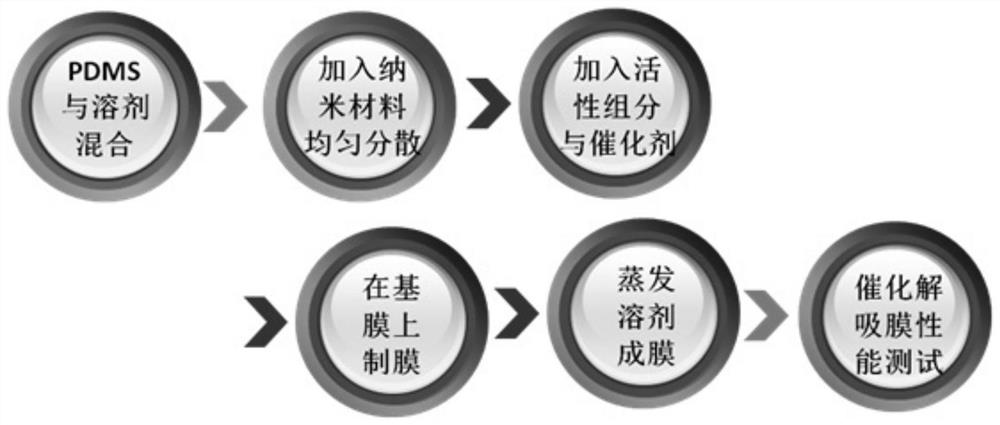A membrane that desorbs CO2 from an aqueous solution containing potassium bicarbonate and its preparation method
A technology of potassium bicarbonate and aqueous solution, which is applied in the field of CO2 desorption membrane and its preparation, can solve the problems of reducing desorption temperature, and achieve the effects of reducing desorption temperature, desorption energy consumption, and energy consumption
- Summary
- Abstract
- Description
- Claims
- Application Information
AI Technical Summary
Problems solved by technology
Method used
Image
Examples
Embodiment 1
[0022] according to figure 1 Flowchart shown for the preparation of CO desorption from an aqueous solution containing potassium bicarbonate 2 membrane (catalytic desorption membrane).
[0023] Take dimethylsiloxane (PDMS) 11.5g, add solvent n-heptane 45g, add TiO 2 Nanomaterials (60nm) 0.35g, strongly dispersed evenly; add active crosslinking agent vinyltrimethoxysilane 1.8g, add catalyst dibutyltin dilaurate 0.5g, stir at 20°C for 2.5h; The base membrane is a polyacrylonitrile microfiltration membrane (pore size 20 microns), the thickness of the active layer is controlled to be 35 μm, and the film is formed by evaporation at room temperature.
[0024] Membrane performance test: CO desorption from 20% (wt) potassium bicarbonate aqueous solution 2 , the desorption temperature is 70°C, and the desorption rate of potassium bicarbonate is 40.2%.
Embodiment 2
[0026] according to figure 1 Flowchart shown for the preparation of CO desorption from an aqueous solution containing potassium bicarbonate 2 membrane.
[0027] Take PDMS 11.3g, add solvent n-hexane 50g, add SiO 2 Nanomaterials (50nm) 0.55g, strongly dispersed evenly; add active crosslinking agent ethyl silicate 1.5g, phenyltriethoxysilane 0.8g, add catalyst dibutyltin dilaurate 0.5g, stir at 25°C for 3.5 h: Use a membrane-making mechanism to make a membrane, the base membrane is a polydimethylsulfoxide microfiltration membrane (pore size 30 microns), control the thickness of the active layer to 15 μm, and evaporate to form a film at 30°C.
[0028] Membrane performance test: CO desorption from 25% (wt) potassium bicarbonate aqueous solution 2 , the desorption temperature is 75°C, and the desorption rate of potassium bicarbonate is 45.5%.
Embodiment 3
[0030] according to figure 1 Flowchart shown for the preparation of CO desorption from an aqueous solution containing potassium bicarbonate 2 membrane.
[0031] Take 12.5g of poly PDMS, add solvent n-hexane 50g, add TiO(OH) 2 Nanomaterials (60nm) 0.65g, strongly dispersed evenly; add active components ethyl silicate 1.5g, N-aminoethyl-3-aminopropyltrimethoxysilane 0.6g, polydopamine 1.1g, add catalyst dilaurel Dibutyltin dibutyltin 0.6g, stirred at 35°C for 4h; use a membrane mechanism to form a membrane, the base membrane is a polydimethylsulfoxide microfiltration membrane (pore size 30 μm), control the thickness of the active layer to 70μm, and evaporate to form a film at 50°C.
[0032] Membrane performance test: CO desorption from 25% (wt) potassium bicarbonate aqueous solution 2 , the desorption temperature is 80°C, and the desorption rate of potassium bicarbonate is 50.3%.
PUM
| Property | Measurement | Unit |
|---|---|---|
| pore size | aaaaa | aaaaa |
| thickness | aaaaa | aaaaa |
| particle diameter | aaaaa | aaaaa |
Abstract
Description
Claims
Application Information
 Login to View More
Login to View More - R&D
- Intellectual Property
- Life Sciences
- Materials
- Tech Scout
- Unparalleled Data Quality
- Higher Quality Content
- 60% Fewer Hallucinations
Browse by: Latest US Patents, China's latest patents, Technical Efficacy Thesaurus, Application Domain, Technology Topic, Popular Technical Reports.
© 2025 PatSnap. All rights reserved.Legal|Privacy policy|Modern Slavery Act Transparency Statement|Sitemap|About US| Contact US: help@patsnap.com

